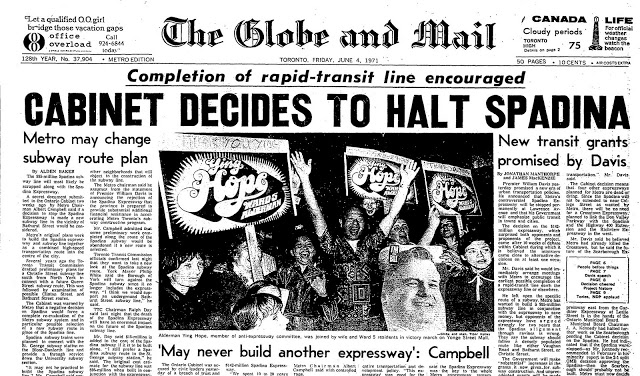
Information to change the world | |
Find Topics, Titles, Names related to your query |

Information to change the world | |
Find Topics, Titles, Names related to your query |
|
|
Stop Spadina Save Our City Co-ordinating Committee (SSSOCCC)By the 1950s, many Torontonians had fallen in love with their cars, and with the rapid growth of the city’s suburbs, people increasingly relied on their vehicles to get to work. This resulted in lots of traffic congestion and longer commuting times. The main attempted solution for that problem was to build high-speed urban highways, dubbed “expressways”, which were off-limits to pedestrians. These expressways often tore through old neighbourhoods, altering their landscapes with wide ribbons of asphalt and concrete tied to overpasses, underpasses, ramps, and collector lanes. As the expressways themselves became congested, demands to build more of them increased. In the mid-1960s, Toronto’s Don Valley and Gardiner expressways were largely complete and had faced minimal opposition. The Spadina Expressway, which was planned to stretch from Downsview to near the lake, was underway and a Crosstown Expressway was being designed. Metro Toronto’s Traffic Commissioner saw Los Angeles as a model for what Toronto’s urban fabric would look like. Support for expressways began to ebb in the late 1960s as a new interest in protecting the environment meant more people wanted to promote public transit and discourage the use of private cars. There was also more concern for maintaining pedestrian-friendly neighbourhoods and protecting old heritage buildings. This coincided with a new culture of activism, where people were more willing to join protests and march in demonstrations, challenge corporations and politicians, and question the advice of the city’s urban planning experts. In October 1969, opponents of the Spadina Expressway formed the Stop Spadina Save Our City Coordinating Committee to coordinate their efforts. Its 1,500 members wrote and published educational materials, led demonstrations, held student sit-ins and lobbied municipal and provincial politicians. Within two years, the Ontario government withdrew its financial support for the expressway, even though tens of millions of dollars had already been spent on it. The committee’s success in demonstrating public unhappiness with the project had turned the tide and led to its cancellation. Expressways had once been politically neutral symbols of progress and modernity, but many people now had different ideas about what progress meant. In one of its more theatrical demonstrations, committee members dressed up in Victorian costumes and marched down streets with horse-drawn carts to make the point that the thinking behind expressways was out of date. They thought that walkable streets, with a mix of old and new buildings, was more in keeping with the times. The activism evident in the Spadina Expressway protests encouraged people to think about what kind of city they wanted. Residents demanded participation in the city’s planning processes. Several important old buildings, like Union Station, were subsequently saved from demolition. More action was taken against polluting industries and other environmental dangers. Cycling lanes began to be built. The definition of urban progress changed. World famous University of Toronto philosopher and futurist Marshall McLuhan was a member of the Stop Spadina Save Our City Coordinating Committee. He argued that old notions of progress had to change if Toronto was to continue to be a livable city: “Toronto will commit suicide if it plunges the Spadina Expressway into its heart. In an age of software Metro planners treat people like hardware; they haven’t the faintest interest in the values of neighbourhood or community. Their failure to learn from the mistakes of American cities will be ours too.” - Peter Graham This article is also available in Korean. Related Topics: Municipal Planning – Roads – Toronto City Politics Related Reading:  |